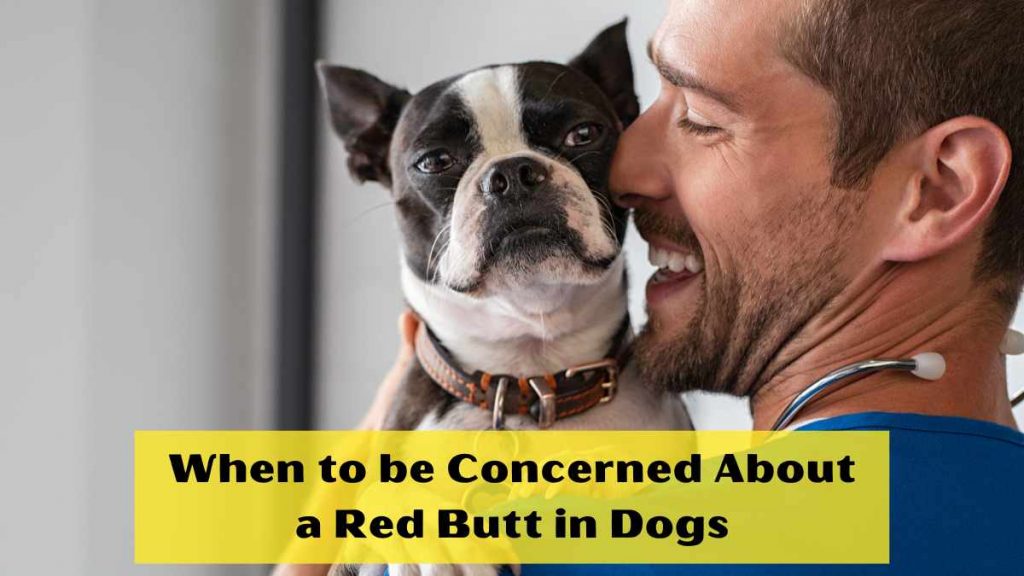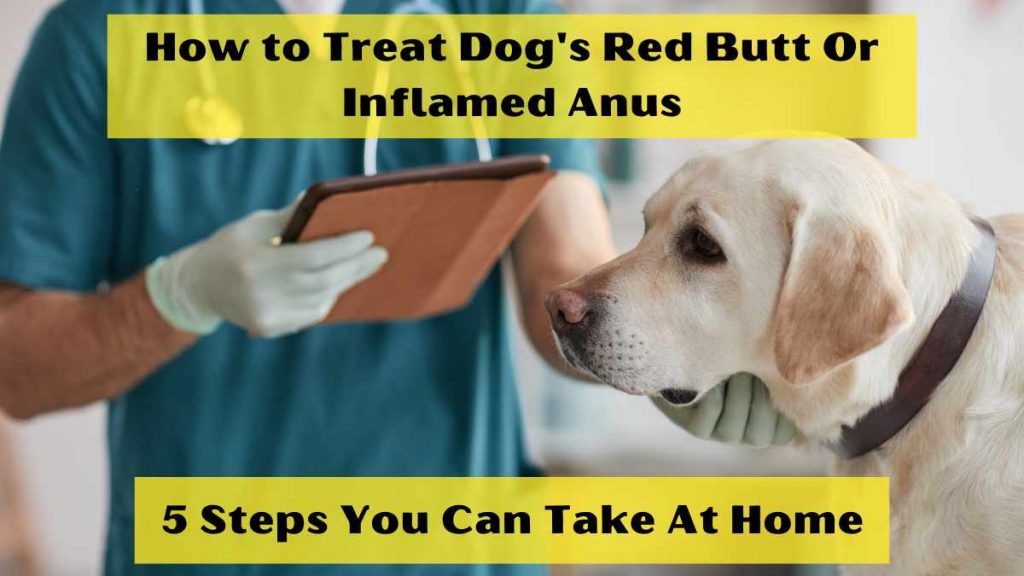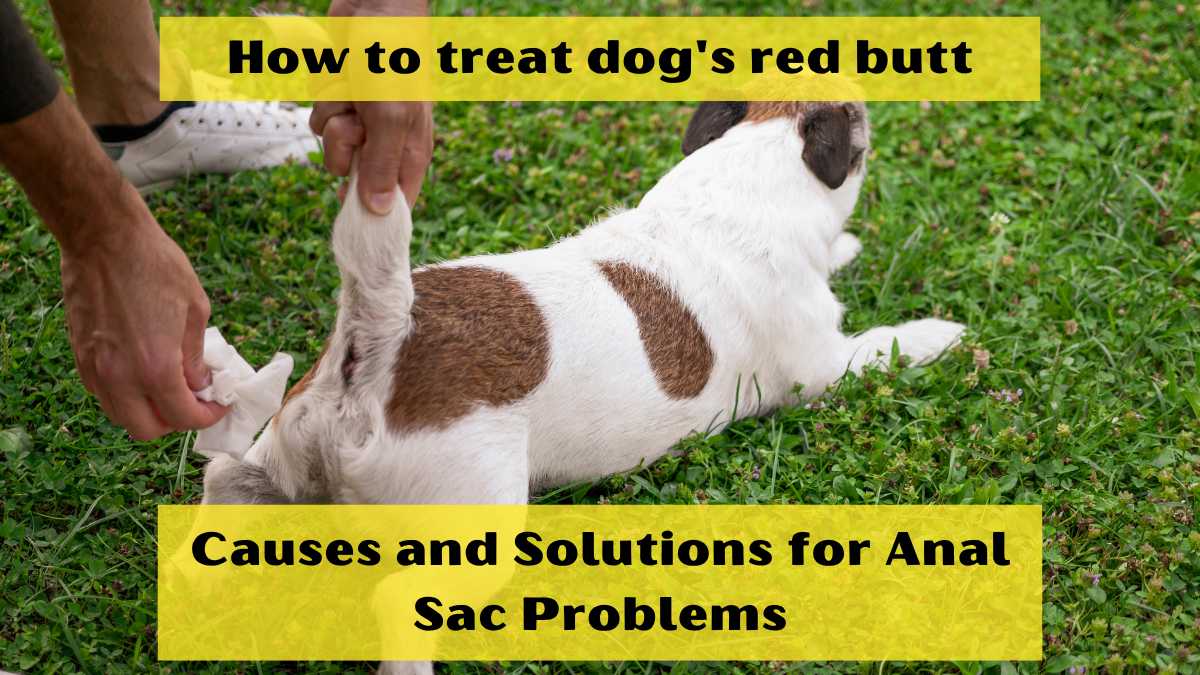Do you know how to treat dog’s red butt that can indicate anal sac problems? You may have seen a dog scoot across the floor or lick its posterior repeatedly if you have a dog. Your dog may be experiencing discomfort or suffering due to a problem with his or her anal sac. Diarrhea, rectal prolapse, perineal malignancies, allergies, and illnesses of the anal glands are just a few of the potential reasons for anal sac issues in dogs that will be discussed in this article.
We will also discuss when you should be concerned about your dog’s red butt and share some steps you can take to help alleviate your pet’s discomfort at home. So, if you’re worried about your dog’s behind and want to learn how to treat a red butt, keep reading.
Table of Contents
What Are The Anal Sac?
Anal sacs, also known as anal glands, are two small pouches on either side of the anus at around four and eight o’clock. Many sebaceous (sweat) glands line the inside of these sacs, which produce an odorous fluid that is then stored there. A little duct or canal that opens immediately inside the anus allows the fluid to escape. Both male and female dogs have these sacs.
What Are The Causes Anal Sac Problems in Dogs

For dogs, anal sac problems can be uncomfortable and painful. Diarrhea, rectal disease, advanced cancer, allergies, rectal prolapsed, and perineal fistula are only a few reasons for anal sac problems.
01. Diarrhea – The Common Cause of Anal Discomfort in Dogs
The increased urgency and strain from urinating might result in irritation and discomfort in the colon and anus in dogs experiencing diarrhea. Stomach acids, digestive enzymes, and bile can bring on the caustic irritation in the stool brought on by diarrhea. The perineal skin becomes inflamed and ulcerated as a result.
Food intolerance, chronic gastrointestinal illnesses, parasites, stress, antibiotic use, and other systemic ailments are only a few causes of diarrhea.
02. Anal Gland Disease – Excessive Scooting, Licking, or Pain During Defecation
Dogs have two anal glands, which may become afflicted or infected for various reasons. The symptoms of rectal disease include frequent scooting, licking, or discomfort during defecation.
Anal glands that are infected might irritate the perineum and produce localized edema. Purulent discharge, rectal rupture, and ulceration close to the anus are all possible. If your dog exhibits any rectal illness symptoms, you must take him to the veterinarian.
03. Rectal Prolapse – Bright Red Tissue Protruding Beyond the Anus
Dogs with cancer, parasites, or persistent diarrhea may be more prone to rectal prolapse. This happens when the anus’s internal lining extends past the anus.
The expanded tissue has a brilliant red appearance and could resemble a bloated tube. Rectal tissue might become distorted and even die in cases of persistent prolapses, necessitating immediate surgery.
04. Perineal Cancers – Anal Gland Adenocarcinoma
An autoimmune disorder that results in severe perineal inflammation and ulceration is the root cause of perineal fistulas.
Dogs with this ailment develop tracts around the anus, which can bleed, make it difficult for the dog to urinate, and cause intense agony. It is vital to consult a veterinarian if you suspect perineal fistulas in German shepherds because they are prone to this condition.
05. Allergies – Itching and Hair Loss Around the Perineal Region
Dogs may develop allergies to their surroundings, food, or skin parasites. The itching and hair loss at the base of the tail is frequently brought on by flea-allergic dermatitis.
Itching, hair loss around the perineal area, pain, and red skin can all be symptoms of chronic allergies. It is crucial to pinpoint the allergens and the underlying cause of the allergy.
When to be Concerned About a Red Butt in Dogs

Anxiety in dogs can result from inflammation and redness around the anus. Not every situation, though, calls for rapid action. Here are some indications that urgent or emergent intervention is needed:
01. Passing Large Amounts of Blood
If you notice that your dog is passing large amounts of blood in its stool, it could indicate that the colon is seriously inflamed or that local blood vessels have been harmed. A tiny quantity of blood in the stool can be observed with minor colon inflammation, and a veterinarian should always be consulted when a significant amount of blood is present.
02. Rectal Prolapse
Rectal prolapse is always regarded as a medical emergency since it occurs when the rectum protrudes through the rectum. Delaying medical treatment can result in rectum necrosis, necessitating emergency surgery if the rectum does not heal independently.
03. Discomfort
Any dog displaying signs of pain or discomfort must be seen by a vet as soon as possible. Constipation can result from untreated pain, which can make it difficult to urinate. Early intervention can help your pet feel better quickly and prevent further developing problems.
04. Perineal Fistulas
Prompt medical attention is advised if you believe your dog has one. Early diagnosis and treatment of the disease are made possible by early detection of the condition. Your pet will have faster alleviation and a greater response to treatment if you intervene early enough to stop the condition in its early stages.
05. Mass
It is advised to consult a veterinarian as soon as possible if you find a mass close to your dog’s anus. Perineal masses detected and treated early can result in rapid treatment and a better overall prognosis.
How to Treat Dog’s Red Butt Or Inflamed Anus: 5 Steps You Can Take At Home

Here are five steps you can take at home to assist your dog with a red or inflamed anus while recognizing the necessity of veterinary treatment:
01. Keep the Anus Clean
Cleaning your dog’s behind regularly is the most crucial thing you can do. Ulcers brought on by caustic diarrhea can be avoided by cleaning up the feces left on the wool.
Cleaning your dog’s buttocks after a bowel movement will help with this. It is advised to bathe the region in cases of severe diarrhea to remove feces lodged in the fur and calm the area.
02. Heals Painful Skin
Topical medications sold without a prescription can relieve itchy or ulcerated skin. You can use safe items like Vaseline and Aquaphor.
These creams build a barrier to treat irritated skin and stop future stinging. After cleaning the surrounding area, use these as necessary. However, watch out for your dog licking the treated area.
03. Problem-Solving for Diarrhea
Simple diarrhea in dogs can be handled at home. You can alter their diet with cooked chicken or finely ground meat combined with white rice.
Most cases of mild diarrhea improve within a day or two with an easily digestible diet. However, before making any dietary modifications, speak with your veterinarian.
04. Use an E-collar
The perineum may need to be licked or chewed by dogs with rectal discomfort. These actions may make pain and inflammation worse. Elizabethan collars are an excellent way to stop your dog from injuring his ear further. This collar might give the affected region time to recover by preventing your dog from reaching it.
05. Preventative Actions
The easiest strategy to stop rectal irritation is to avoid meals that can upset your stomach and make you dizzy. Monthly flea and tick prevention can decrease your dog’s risk of getting diarrhea from gastrointestinal parasites or flea allergy dermatitis. You can lessen your dog’s risk of rectal discomfort by taking precautions.
Conclusion
In conclusion, how to treat dog’s red butt? Anal sac problems in dogs can be uncomfortable and painful. Many conditions, including anal gland illness, rectal prolapse, perineal malignancies, and allergies can bring on anal sac issues. It’s critical to keep an eye on your dog and watch for signs like profuse bleeding, discomfort, rectal prolapse, perineal fistulas, or a lump around the anus.
Even though you understand that your dog needs veterinary care, there are things you can do at home to help him if his anus is red or inflamed. These include keeping it clean, giving him a balanced diet, anti-inflammatory medication, and lowering his stress levels. Early treatment can hasten your pet’s recovery and stop problems from worsening. In order to give your dog the care they need, you should consult your veterinarian as soon as you notice any indications of anal sac issues.
Read more about Why Is My Dog Bleeding From Its Anus?

